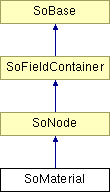
#include <Inventor/nodes/SoMaterial.h>
Inheritance diagram for SoMaterial::

Public Methods | |
| SoMaterial (void) | |
| virtual void | doAction (SoAction *action) |
| virtual void | GLRender (SoGLRenderAction *action) |
| virtual void | callback (SoCallbackAction *action) |
Static Public Methods | |
| void | initClass (void) |
Public Attributes | |
| SoMFColor | ambientColor |
| SoMFColor | diffuseColor |
| SoMFColor | specularColor |
| SoMFColor | emissiveColor |
| SoMFFloat | shininess |
| SoMFFloat | transparency |
Protected Methods | |
| virtual | ~SoMaterial () |
| virtual void | notify (SoNotList *list) |
After traversing an SoMaterial node, subsequent shape nodes with geometry in the scene graph will use values from the material "pool" of the traversal state set up from nodes of this type.
Note that values from a material node will replace the previous values from in the traversal state, not accumulate.
FIXME: usage example here. 20020118 mortene.
FIXME: describe what happens if the number of values in the fields is not consistent. 20020119 mortene.
FIXME: refere to the OpenGL color model. 20020119 mortene.
Note that nodes tagged as VRML V1.0 has a special case, where the fields SoMaterial::ambientColor, SoMaterial::diffuseColor and SoMaterial::specularColor contains zero values, and SoMaterial::emissiveColor contains one or more values. The values in SoMaterial::emissiveColor should then be treated as precalculated lighting, and the other fields should be ignored.
You can detect this case by checking the values of the material elements when the scene graph is traversed using an SoCallbackAction. SoDiffuseColorElement, SoAmbientColorElement, and SoSpecularColorElement will contain one value with a completely black color (0.0f, 0.0f, 0.0f), SoShininessElement will contain one value of 0.0f, and SoEmissiveColorElement will contain one or more values. It is done like this to make rendering work correctly on systems that do not test for this specific case.
You should only check for this case when you're traversing a VRML V1.0 file scene graph, of course. See SoNode::getNodeType() for information about how nodes can be tested for whether or not they have been imported or otherwise set up as of VRML1 type versus Inventor type.
When the scene graph is rendered using an SoGLRenderAction, the elements will be set differently to optimize rendering. The SoDiffuseColorElement will be set to the values in SoMaterial::emissiveColor, and the light model will be set to SoLightModel::BASE_COLOR.
The SoMaterial::transparency values will always be treated normally.
|
|
Constructor. |
|
|
Destructor. |
|
|
Sets up initialization for data common to all instances of this class, like submitting necessary information to the Coin type system. Reimplemented from SoNode. |
|
|
This function performs the typical operation of a node for any action. Reimplemented from SoNode. |
|
|
Action method for the SoGLRenderAction. This is called during rendering traversals. Nodes influencing the rendering state in any way or who wants to throw geometry primitives at OpenGL overrides this method. Reimplemented from SoNode. |
|
|
Action method for SoCallbackAction. Simply updates the state according to how the node behaves for the render action, so the application programmer can use the SoCallbackAction for extracting information about the scene graph. Reimplemented from SoNode. |
|
|
Notifies all auditors for this instance when changes are made. Reimplemented from SoNode. |
|
|
Ambient material part color values. Will by default contain a single color value of [0.2, 0.2, 0.2] (ie dark gray). The ambient part of the material is not influenced by any lightsources, and should be thought of conceptually as the constant, but small contribution of light to a scene "seeping in" from everywhere. (Think of the ambient contribution in the context that there's always photons fizzing around everywhere -- even in a black, lightsource-less room, for instance). |
|
|
Diffuse material part color values. This field is by default initialized to contain a single color value of [0.8, 0.8, 0.8] (light gray). The diffuse part is combined with the light emitted from the scene's light sources. |
|
|
Specular material part color values. Defaults to a single color value of [0, 0, 0] (black). |
|
|
The color of the light "emitted" by the subsequent geometry, independent of lighting / shading. Defaults to contain a single color value of [0, 0, 0] (black, ie no contribution). |
|
|
Shininess values. Decides how the light from light sources are distributed across the geometry surfaces. Valid range is from 0.0 (which gives a dim appearance), to 1.0 (glossy-looking surfaces). Defaults to contain a single value of 0.2. |
|
|
Transparency values. Valid range is from 0.0 (completely opaque, which is the default) to 1.0 (completely transparent, i.e. invisible). Defaults to contain a single value of 0.0. |
 1.2.9 written by Dimitri van Heesch,
© 1997-2001
1.2.9 written by Dimitri van Heesch,
© 1997-2001